Scroll through the lesson and click on notation/video/audio links to load the interactive players.
Please subscribe to get full access to all lessons for only $7.95/month PLUS 1 week free trial.

Riff Interactive lessons are
LESS expensive and
MORE interactive than alternatives!
More Info
|
|
| Lesson Subject:
Beginning Classical Guitar |
| What you learn:
Romanza (Romance) |
| Teacher:
Storm Stenvold |
Romanza (Romance)
Storm: Hello class, our lesson today will
cover the classical guitar standard "Romanza" or 'Spanish
Romance'. Romanza is one of my favorite tunes to
teach classical right-hand technique, so put away your guitar picks and we'll
get started. For this lesson we will focus on the thumb, index, middle and ring fingers of
the picking
hand. Below is an illustration on positioning your fingers, notice how the thumb
runs horizontally on the 6th string (E) and how the fingertips claw the
higher strings.
Right Hand
Classical
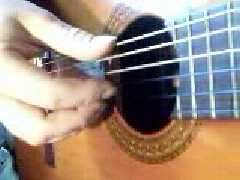
Storm: Traditionally classical guitar
compositions are played on a nylon string acoustic, but you can play on a
steel-string acoustic or electric guitar as well if you do not have access to a
classical. Classical guitar is played in a seated position, with the guitar
resting on the left leg which is raise 5-6 inches by using either a footstool or
some other item like a book or block of wood. The classical guitar is designed
specifically for finger picking, featuring a wide fretboard and the strings
being spaced farther apart to allow the fingers to fit comfortably under or on
each string. The thumb usually covers any notes played on the
lower note strings (6th-E, 5th-A, 4th-D) and the index, middle and ring fingers will respectively cover the 3rd (G), 2nd (B) and 1st (E) strings.
You use the fingernail as a pick to actually make contact with the strings. Here is
the opening measure of Romanza.
Storm:
In classical, the right hand fingers are
denoted as such: P= thumb, I= index, M= middle, A=ring. Notice that you play the
6th (E), 1st (E), 2nd (B),
and 3rd (G) strings. The picking pattern is Thumb and ring finger together, middle, then index
finger. The next two times you use the ring, middle then index fingers. Also
notice how the bass note sounded by the thumb continues to
ring. I'd like to also point out that Romanza is in 3 counts per measure and
each beat is divided into triplets. Here is a video of the picking pattern:
Video - Right Hand Picking
jay:
Not use to this.
Storm: Jay, why don't you try slowing down the opening tab and
looping it using the Riff tools. This is a great exercise to build up the independence of the right
hand fingers which is a must for classical guitar. Here's a looping sound clip of the pattern at about 120
BPM (beats per minute), which is considered a moderate tempo. Try playing slower to a metronome
(if you have one) this
week while you pay attention to the technique.
Looping
Right Hand Picking
Storm: The open strings work well if
you concentrate on the right hand finger picking technique. You can hear how the
E minor chord is at the heart of this section which is a key point of this tune.
You
can slow this section way down and still hear the chord structure and melody of the
piece. Here are two more measures (bars 2 and 3) that descend the first string to add
melody on top of the E minor chord.
jay: You change fingering why?
Storm: Jay, changing the fingering allows me to
move positions along the first string (E) cleanly without sliding. Try
practicing the left hand positions below.
E minor - 1st Run
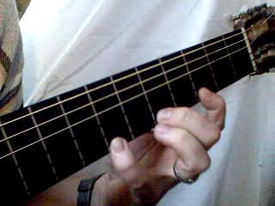
E minor - 2nd
Run

Storm: You use your 4th finger to set up the
notes that follow in the next phrase. Next we will move back up the
neck. Here's the next section.
Storm: Now you
move your hand back to the lower frets again, leading you into our next chord.
Storm:
This covers the first six bars.
E minor - 3rd Run
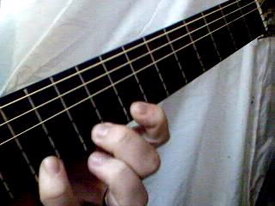
Storm: In the next two bars you play an A bass
note while playing a C, B and A melody line (1st string). This section is based
on the A minor chord.
Storm:
Now you will need to barre your 1st finger on the 5th fret while covering the 1st, 2nd and 3rd strings.
This technique is called 'half-barre,' basically because you don't cover all 6
strings like in most barre chords.
A
Minor

Storm: The melody now descends in bar 7, and back
in bar 8. This brings us back to the 'big stretch' in the first
section.
Storm:
Now you play in the 7th fret position using a full barre across all six
strings.
B7 - 7th
Position
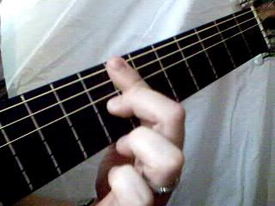
Storm: You can now add melody notes to the 7th
fret barre position by using the 3rd finger on the 8th fret.
jay: That 11 is a stretch without lifting.
Storm: Yes Jay, the 4 fret stretch to the
11th fret while you're still holding the barre on the 7th fret is quite a
challenge.
B7 - C
Melody
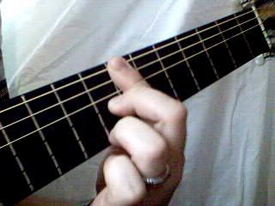
B7 - D#
Melody
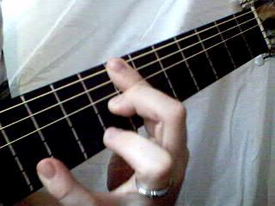
Storm: This section covers bars
9-10.
Storm:
You finish the section in open position, which is a standard B7
chord.
jay: Man
and this is "just" a warm up?
Storm: No, it's a song. Bits and pieces of it
make great right hand/left hand exercises, though.
jay:
Aren't we looking at 1-4-5 blues
progression?
Storm: Yes, based in E minor. This will help
you to analyze the harmony structure used in this piece.
jay: Very cool classical blues!
B7
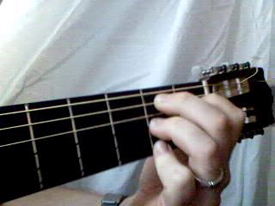
ECid:
Teach what scales could we use on this?
Storm: ECid, you can basically play using the E minor
scale throughout this piece and even change to the E Harmonic Minor during the B7
chord if you like.
Storm: In the next section you return by
playing the E minor chord in the open position, but this time the bass notes are
played on each beat, rather than the 3 beat long 'dotted
half-notes' you used in the rest of the piece.
Storm:
All of the phrases come from underlying chord shapes. Playing chords one
note at a time is called an 'arpeggio'. The entire melody structure of Romanza is built on
arpeggios and one of the main points of this lesson.
E minor - Final
Run

Storm: The last strike of the chord separates
the notes slightly for more emphasis in the last phrase.
Storm: We will cover the second section of
Romanza which is in E major in the next lesson. Goodnight
everyone
|
<< load notation from left
|
|
<< load audio from left
|
<< load audio from left
|